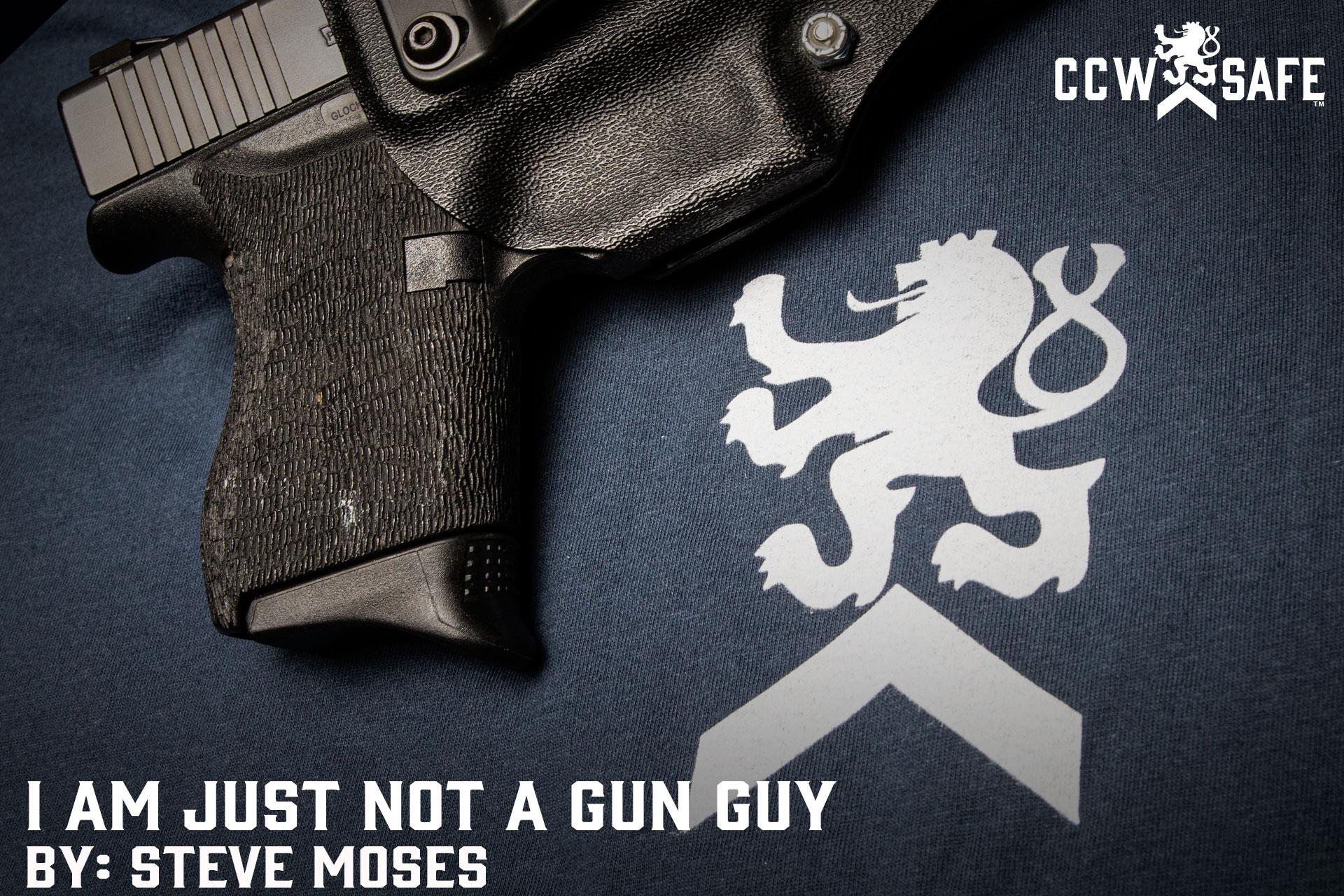
Posted on November 22, 2021
I AM JUST NOT A GUN GUY
I recently had a conversation with a long-time friend and her husband regarding home security and the importance of owning and being able to use a defensive firearm. My friend was completely sold on the idea, but her husband was less so. At one point, he said “I am just not a gun guy,” to which I responded with “Are you a defend your home and family guy?”
As a CCW Safe content creator and Firearm Trainers Association customer support and content creator I use a laptop computer almost every day of the week. I am not a computer guy. I know that one is a HP and the other a Mac, but little else. Furthermore, I do not care to know any more than that. I do however know how to operate both of them and am skilled enough to write articles and generate certificates of coverage and range endorsements. It is my opinion that it is not necessary that an armed homeowner (and potential concealed carrier) needs to know much more than that when it comes to defensive handguns, but it is necessary that he or she needs to know how to operate one and use it skillfully and appropriately.
Naturally, there are laptop computers and handguns that are sub-par and should be avoided. There is also a plethora of striker-fire 9mm handguns like the Glock 19 and 48 and Smith and Wesson M&P M2.0 and Shield that make great first (and last) defensive handguns. One exception is the Smith and Wesson M&P 22 Compact in .22 Long Rifle (more on this later). In my opinion, experienced concealed carriers talking to potential first-time gun owners should encourage them to avoid Double Action/Single Action semi-automatic pistols as well as those that must be carried cocked-and-locked (hammer back and safety engaged) like the various 1911 Government models. In my opinion, concealed carriers who are not willing to put in a lot of dry-practice and live-fire work with those systems are more likely under stress to injure themselves or others with their own handgun.
At a bare minimum, prospective gun owners should take at least a NRA Basics of Pistol Shooting class. Better yet would be an eight or sixteen-hour Defensive Pistol class taught by an experienced instructor that includes blocks of instruction on Use of Force laws, gun safety, gunhandling, marksmanship, and threat management. For reasons that I do not fully comprehend many prospective gun owners have a tendency to place convenience, time, and money ahead of defensive handgun training and procrastinate. That is very much like not wearing one’s seatbelt or letting his or her automobile insurance lapse because the odds are in their favor that they will not be involved in a car wreck that day. It was the late, great firearms trainer William Aprill who made the following observation: “It is not the odds, it is the stakes.”
It is usually not that hard to convince others that law enforcement is unlikely to arrive quickly enough to a 911 call to prevent them from being harmed or killed by a violent home intruder. I recently read an article published in 2018 that stated that the average response time for the Fort Worth Police Department was nine minutes and twenty-seven seconds. It is no secret that in 2021 many urban law police departments are under-staffed, some seriously. In other words, homeowners are ultimately responsible for their own rescue.
Concealed carriers concerned about the safety of loved ones and friends can sometimes overcome their reluctance to arm themselves by simply taking them to the range and engaging in an informal shooting session. This is a great time to focus on the four rules of firearms safety, which can go a long way towards reducing their apprehension. Handguns are designed to not suddenly go off on their accord. It normally requires some sort of action such as placing the index finger on the trigger and depressing it to make it fire. Proper gunhandling is easily taught, as well as how to child-proof firearms.
In reference to the Smith and Wesson M&P 22 Compact made earlier, it is a great gun for introducing prospective gunowners to shooting. I am currently have some significant problems with my left wrist (I am right-handed) and had enrolled in the Rangemaster Master Firearms Instructor course in which a block of instruction called for shooting from the support side using a holster also worn on the support side. Rather than subject my wrist to potentially additional damage prior to an upcoming surgery I opted to purchase a Smith and Wesson M&P 22 Compact in .22 Long Rifle caliber in order to minimize recoil, and found myself quite smitten with the little pistol. I put over three hundred rounds through it using a variety of ammunition without a malfunction.
Not only is it (or a similar handgun of the same size in .22 Long Rifle caliber) a good handgun for a prospective handgun owner to start with but it may be all that some people with compromised hands and wrists are able to handle. Some “gun guys” are dismissive of small caliber handguns and are not willing to recommend any caliber below 9mm or .38 Special caliber for self-defense. I too prefer handguns in those calibers (or greater) but subscribe to the theory that a small-caliber handgun that works in the hands of a person that shoot it well is far superior to no handgun at all. Rifles and handguns chambered in .22 Long Rifle are often used for self-defense and actually have a decent record for terminating violent physical attacks. More than likely, the majority of those attacks were stopped because the attacker did not want to be shot or shot some more.
In summary, when dealing with persons who I care about who are uncertain about acquiring a handgun for self-defense, I typically avoid going into a long diatribe about why they are wrong and what they should get. Instead, I focus first on the fact that bad things do happen to good people and that if it involves violence it is extremely unlikely that anyone is going to be able to come to their aid fast enough to make a difference. There is never just one victim of a violent criminal attack. Their loved ones are impacted also, some to a great extent. I talk about all the steps they can take to “harden” their house, how they can move more safely while transitioning from home and back where they are more likely to encounter other people, and how they might set boundaries when approached by persons of questionable intent.
If I think they can manage a full-sized or compact handgun in 9mm or .38 caliber I recommend that to them. If not, I suggest starting out with something like the Smith and Wesson M&P 22 Compact. Once that is accomplished, I suggest a larger caliber handgun to those that can operate one. If not, I advise them that a .22 Long Rifle is not as powerful as a 9mm or .38 Special and that the best way to defend themselves is to get some training and shoot it monthly at the range using small index cards taped to the upper chest of a humanoid paper target. Lastly, I caution them against dry-firing the pistol without a dummy round in the chamber (a full magazine of dummy rounds cycled by hand using the tap-rack method is a training bonus) and encourage them to use the more expensive, high-quality .22 Long Rifle ammunition for defensive purposes. One of the negatives of rimfire ammunition is that on occasion the primers do not detonate, and this is especially true with inexpensive training ammunition.
My thoughts above are based upon working with hundreds of students over a period of nearly thirty years in which I was around persons whose ages ranged from eighteen to eighty-four. I watched people with all sorts of physical infirmities learn how to shoot handguns because that they knew that the calvary was not going to arrive on time if they were caught up in a life-threatening situation. For every one of them there is probably hundreds (if not thousands of persons) who are not interested in owning a handgun that concealed carriers love and/or care about. Some we can influence, and some we cannot. This article is written for those we can.
 |
Steve MosesSteve Moses has been a defensive firearms trainer for over 26 years and is a licensed Texas Personal Protection Officer with 7 years of experience performing as shift lead on a church security detail for a D/FW area metro-church. Steve is a co-owner and Director of Training for Palisade Training Group, LLC based in Dallas, Texas. Moses is a retired deputy constable and spent over 10 years on a multi-precinct Special Response Team. He owns multiple instructor certifications, including Rangemaster Advanced Handgun Instructor and Defensive Shotgun Instructor, Red Zone Knife Defense Instructor and Adaptive Striking Foundations Instructor, Modern Samurai Project Red Dot Sight Instructor, and State of Texas Personal Protection Officer Instructor. Steve holds a BJJ Brown Belt in Relson Gracie Jiu Jitsu. He is a content contributor for CCW Safe and writes weekly articles on various subjects of interest to concealed carriers. Moses shoots competitively and holds an IDPA Expert rating. Steve is an annual presenter at the Rangemaster Tactical Conference. |